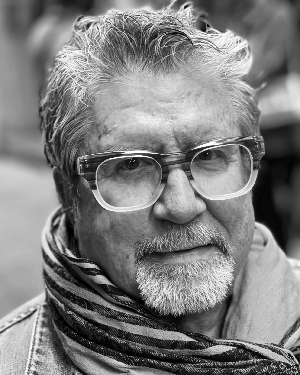E. Eastman, MPT, MFA : Making meaning and sharing stories
E. Eastman wanted his retirement to have meaning and fulfillment. He found both by combining his art with volunteering.
 “I say this all the time to people who are retiring: For a while, all you want to do is lie on the couch in your pajamas and watch stupid TV,” says Eastman, a former physical therapist who spent 21 years in clinical and administrative roles at UCSF before retiring in 2011. “And then you say to yourself, ‘Is that all there is?’ You go from a very engaging environment to being all by yourself. The mental stimulation is missing. That’s why I started volunteering.”
“I say this all the time to people who are retiring: For a while, all you want to do is lie on the couch in your pajamas and watch stupid TV,” says Eastman, a former physical therapist who spent 21 years in clinical and administrative roles at UCSF before retiring in 2011. “And then you say to yourself, ‘Is that all there is?’ You go from a very engaging environment to being all by yourself. The mental stimulation is missing. That’s why I started volunteering.”
Having embraced his own literary talents in retirement, Eastman has also helped children hone their writing skills at 826 Valencia, a nonprofit in San Francisco’s Mission District that helps young people hone their writing skills and encourages teachers to inspire their students to write. The organization also hosts a course that teaches older adults how to write their memoirs.
“Everyone has a story to tell,” Eastman says.
He also became increasingly involved with the UCSF Retirees Association, first simply enjoying its educational offerings, then joining the board in 2019. He served as secretary and vice president and now is the association’s president.
“I think volunteering with the board provides a sense of purpose,” Eastman says. “It also helps out at a cocktail party to say, ‘I’m now president of the board of the UCSF Retirees Association.’ So street cred comes with it too.”
Entering a Caring Profession
E. Martin Eastman (E. is his first name and does not stand for anything) was born in Munich, Germany, where his father was stationed in the US Air Force. The family moved around every two to three years during his childhood, including stints in Spain and various US locations.
He spent his high school years in Boston and Washington, DC, before enrolling in Boston University. As an undeclared undergraduate, he was interested in writing, drawing, and the humanities. But a battery of personality and career-placement tests told him he was best suited to a career as a doctor, psychologist, or physical therapist.
“It was very specific,” he says. “Those three. It wasn’t social work. It wasn’t police officer. It was definitely a medical orientation. Physical therapy seemed to combine elements of the other two, in that I could practice medicine and psychology at the same time. It became a practical and achievable goal.”
Employment in a variety of health care settings followed – from acute rehab clinics to pediatrics. He worked three years in a medical-therapy unit for California Children’s Services (CCS), providing physical, occupational, and speech therapy services for children with disabilities. After returning to Boston University for a master’s degree in physical therapy with a concentration in pediatrics, he moved to San Francisco and was hired as director of the CCS program in Contra Costa County.
When the commute from the city became increasingly challenging, he made the move to UCSF, signing on as assistant director of rehabilitation services in 1990. UCSF remains a special place for him.
“I always thought the mission of the university was noble,” Eastman says. “And it’s a huge, worldwide institution. If you need brain surgery, you go to UCSF. They’ve got the latest techniques. There’s a sense of excitement that persists in the environment.”
He grew weary of being in management and returned to patient care – primarily home care – for the remaining 17 years of his physical therapy career.
“That became my specialty: caring for people in their own homes,” he says.
The Artist’s Way
The 9/11 terrorist attacks prompted a change.
“I remember sitting in my car that morning and saying to myself, ‘If that were me having to jump out of a window from the 72nd floor, what would I have regretted not doing?’” Eastman says.
That moment of reflection led him to enroll in the creative writing program at the University of San Francisco, where he earned a Master of Fine Arts degree. He has since written a memoir of linked essays. Three of them have been published in literary journals and won prizes, and he is hoping to have the collection published in the near future.
“In the beginning, I was an artist, a lover to paper, crayons, colored pencils, to scissors and glue, to all that symbols, shapes, and shadings could represent,” he writes in the memoir.
He’s an artist still, with his next book already percolating. It is based on years of extensive notes from his time as a physical therapist in home care. “It’s about going into people’s homes and what you find when they open the door,” he says.